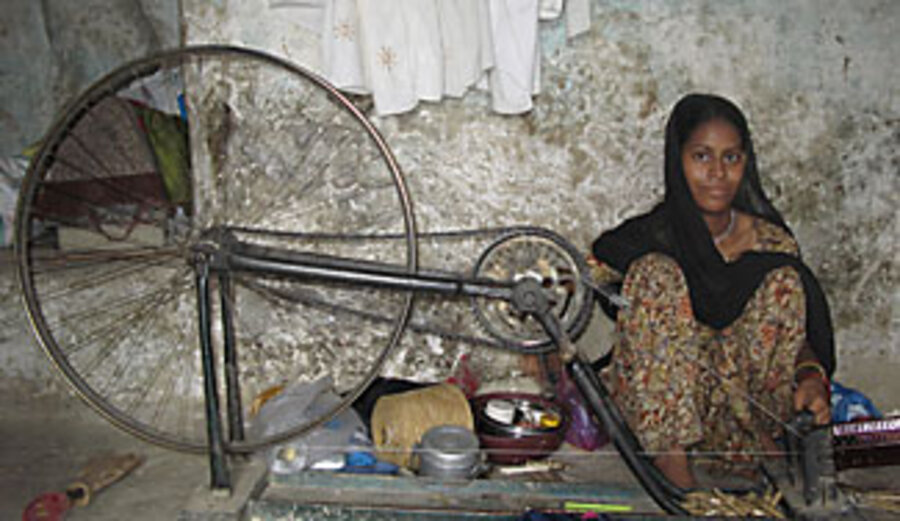Indian weavers sidelined by market forces
| Varanasi, India
In a windowless hut lit only by the sunlight pouring through an open door, a bone-thin man bends over his wooden hand loom, weaving a shimmering silk sari with violet, turquoise, and gold threads.
The beautiful six-meter-long garment will take 10 days to complete and will fetch the weaver, Abdul Majid, 600 rupees (approximately $14), which is little more than he would have earned for the same work a decade ago.
Diminishing demand for handwoven saris coupled with competition from power looms – which belt out several garments a day – in other parts of India as well as China have left the 300,000 hand loom weavers of Varanasi, a city in northern India, wretchedly poor. Once prosperous, craftsmen like Mr. Majid are now struggling to survive.
The increased competition also affects Majid's family: beside him, his sweet-faced, 7-year-old son, Ashraf, helps him weave the leaf pattern running down the sari's edge.
Nearby, his 15-year-old daughter, Rakshanah, is deftly spinning thread on a foot-powered wheel that appears to have been manufactured out of an upturned pedal bike.
Neither child has ever been to school, says Majid's tired-looking wife. Like most weavers' children, their labor is needed at home.
The Varanasi-based People's Vigilance Committee on Human Rights says that a number of weavers and their children have died of starvation in the city in recent months.
"It is so difficult to feed the family," says Majid, who himself looks undernourished. When he completes the sari he is painstakingly weaving, the proud artisan admits that he has no more work. "I don't know what will happen next."
A tradition in decline
Varanasi has long been famed for its silk saris. In India, hand-woven saris are to this ancient city what tea is to Darjeeling or papier mache ornaments to Kashmir.
Praised in ancient religious texts, Varanasi's silks were particularly celebrated by the Mughals in the 16th and 17th centuries. So loyal was the Mughal courts' patronage of the hand-loom craft that many weavers converted to Islam. Today, 90 percent of Varanasi's weavers are Muslim.
"Even in the 21st century, Varanasi's woven silk saris and fabrics remain the finest and most elaborate loom-patterned textiles in the Indian weaving tradition," says Rahul Jain, a leading Indian fashion designer.
But today, Varanasi's weavers are typical of the millions of Indians left behind by market forces while elsewhere, India booms. They live hidden away too, in neighborhoods reached by narrow lanes, out of sight of tourists who throng India's holiest Hindu city, picking up silk handweaves – or machine-made cloth passed off as the real thing – for a song.
As more Indian women wear jeans and business suits, the taste for Varanasi's intricate weaves is disappearing. The closets of middle-class and upper-middle-class women once burst with sumptuous handwoven saris in every hue. But today they buy such garments primarily for their wedding trousseaus.
Fickle fashions worsen the plight of the weavers. The extravagant embellishments – sequins, crystals, and embroidery – now in vogue are better suited to plainer silks, woven on power looms, than to multitextured handweaves.
The weavers' downturn has been exacerbated by a structural failure to adapt to changing market conditions. Many weavers are stuck dealing with traders who might not buy their products or offer a fair price, but continue to prevent them from selling their wares to anyone else, explains Adarsh Kumar, chief executive of the All India Artisans and Craftworkers Welfare Association, a New Delhi-based organization that works to improve artisans' access to markets.
Since hand-weavers group into small cliques along complex village and caste lines, they have not pulled together to find more efficient ways of doing business.
For example, an entrepreneur who wants to invest in hand looms would find it impossible to bring the necessary number of weavers together to work on a project, says Mr. Kumar.
"What we really need is for crafts in India to reposition themselves, like in Italy, where handmade has a high value. That hasn't happened in India yet," he adds. "These skills could have been redeployed into making curtains, for example, but that transition has never been made."
Resorting to unskilled labor
Instead, a different kind of transition – from skilled labor to unskilled labor – is under way. Indeed, many weavers are opting for rickshaw pulling and daily-wage construction work.
Many weavers' huts in Majid's neighbourhood, which once thrummed with the click-clack of looms, now lie empty. Inside, those carefully crafted wooden looms lie covered in dust and cobwebs.
Nizamuddin Ansari closed the door on his hand loom hut last year and started working as a bicycle rickshaw driver. As a weaver, he was earning the same 300 rupees a week as he had made 10 years ago, which was not enough to feed his seven children.
As a rickshaw driver, he earns 125 rupees a day. Both jobs are tough: "Rickshaw driving hurts my feet; bending over a loom hurt my stomach," he says. But Mr. Ansari wistfully admits that he would prefer weaving the designs passed down in his family for "hundreds of years."





